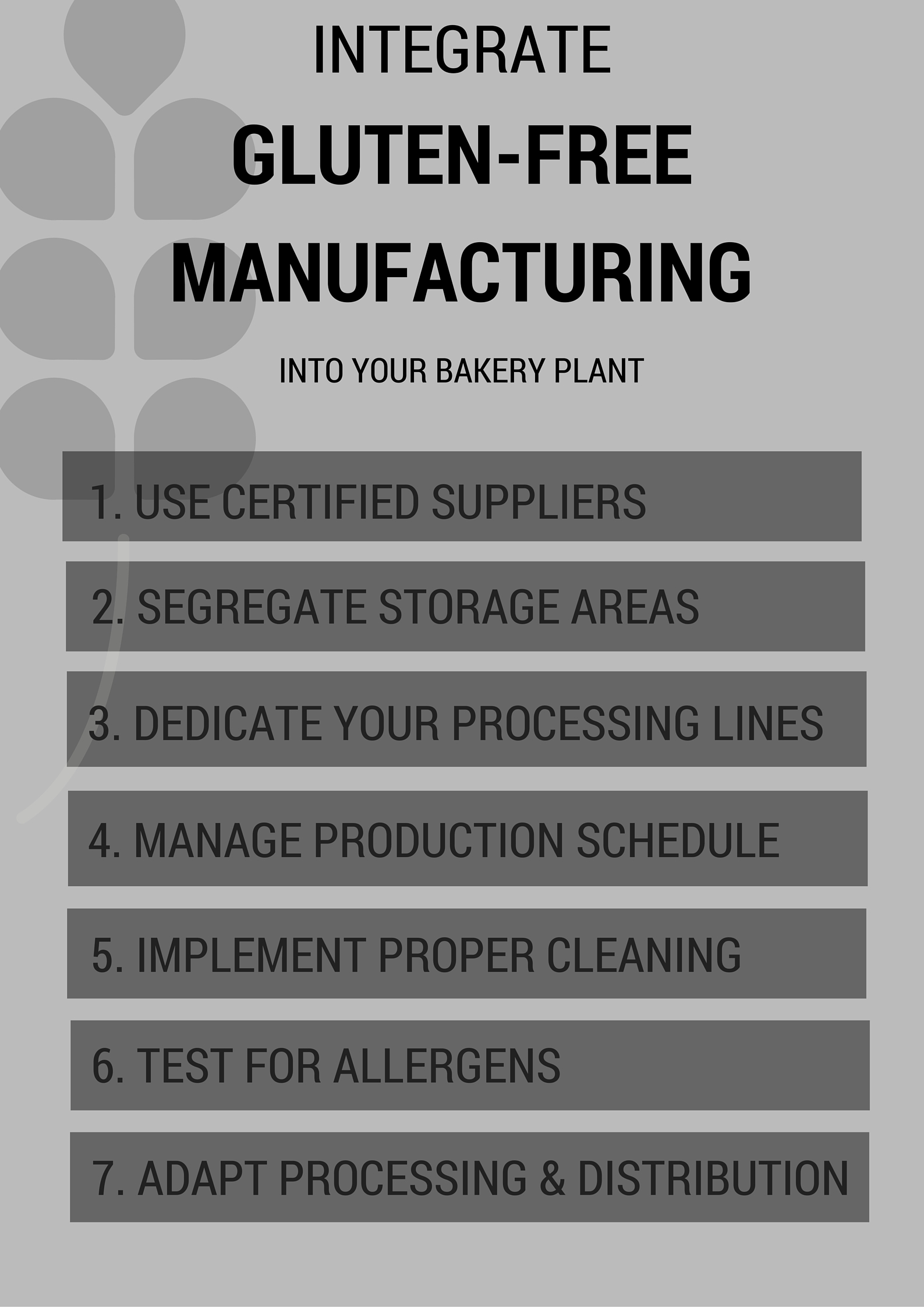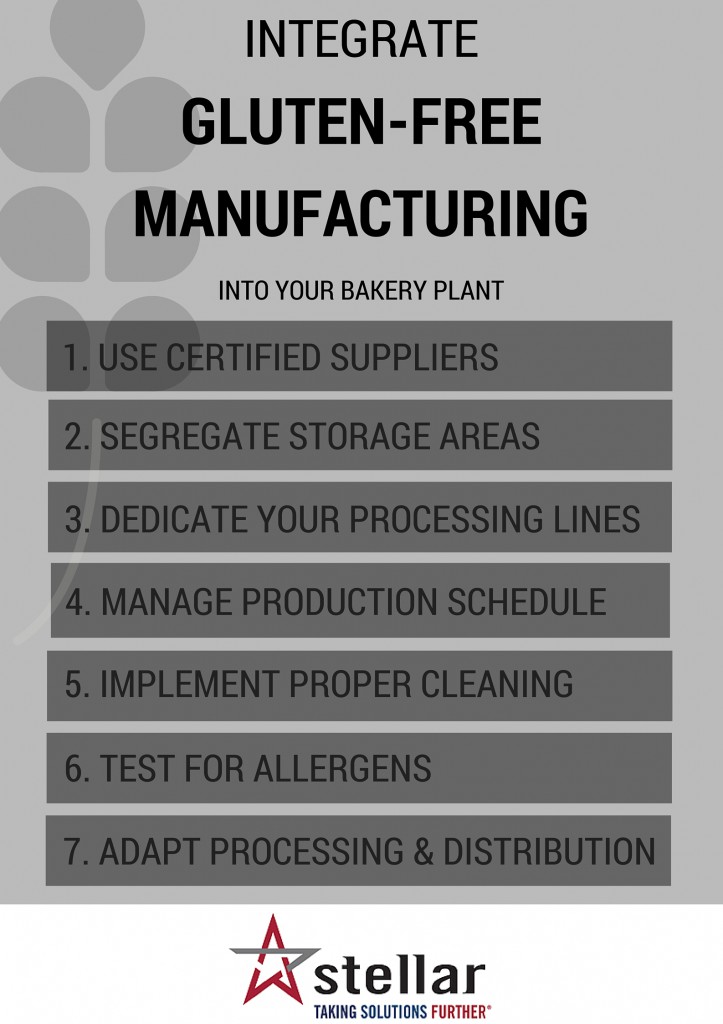Stellar recently exhibited at the American Society of Baking’s (ASB) annual BakingTech conference in Chicago. “Gluten-free” continues to be a topic on the rise among the attendees. This isn’t surprising, as more and more companies are incorporating gluten-free products into their offering arsenals. However, a common challenge for food manufacturers going gluten-free is preventing cross-contamination, whether it’s modifying existing plants or embarking on greenfield projects. Gluten-free products also require specific distribution and processing considerations that may differ from what manufacturers are used to, from mixing methods to storage. So, how do you safely integrate gluten-free manufacturing into your bakery plant?
Before we go any further, let’s examine the allergen itself.
Gluten is the protein that is found in certain grains, specifically wheat, barley and rye. Customers who eat gluten-free for medical reasons fall on a spectrum ranging from a mild allergy to moderate intolerance to severe celiac disease. While only one in 133 Americans (about one percent of the population) have celiac disease, one in five Americans (20 percent) actively try to incorporate gluten-free foods into their diet. It’s safe to say there’s a healthy market interest for gluten-free products.
What makes a product “gluten-free”? The FDA requires that food with a gluten-free label contain less than 20 ppm (parts per million) of gluten. This is the same as having 0.002 percent of gluten in your product. Imagine breaking a cookie into a million pieces. If you wanted to see the FDA’s maximum amount of gluten allowed in a gluten-free product, you would need 20 pieces of the broken cookie.
Learn how to integrate gluten-free products into your food plant safely by following the below best practices:
1. Use certified suppliers—As mentioned above, it only takes a small amount of gluten to make consumers with allergies sick, so it is important to guarantee that every component of your product is allergen-free. This stems from your supplies. One of the easiest ways to know your supplies are allergen-safe? Use a certified supplier. Authorities such as the Gluten-Free Certification Organization set strict standards for suppliers. Using supplies that have been certified by a third party provides an extra layer of protection for your gluten-free customers.
2. Segregate storage areas—After securing a shipment from an approved gluten-free supplier, the easiest way to immediately contaminate these supplies is to mix them with your current stock. Even dust particles from gluten ingredients and products can contaminate your gluten-free ingredients. Some ways to avoid this include:
- Specifying a separate unloading bay for your gluten-free products. This will eliminate the risk of cross-contamination in your unloading process. Engineers can also provide recommendations for including dedicated ingredient-delivery systems for allergens.
- Storing gluten-free ingredients separately from non-gluten-free ingredients.
- Color-coding or marking your allergen ingredients to differentiate them from the rest of your supply.
- Examining your ventilation system, ensuring contaminating particles cannot move in-between separated storage areas.
3. Dedicate your processing lines—The best way to ensure that your gluten-free product stays as “clean” as possible is to process it separately from your other products. Process engineers can often evaluate and provide recommendations to reconfigure existing production areas to include a dedicated allergen line. This eliminates any contamination risk on the lines themselves. Additional ways to keep your product safe for consumers include:
- Ensuring your plant staff is familiar with best practices for allergen foods. This includes changing gloves and/or aprons when appropriate and proper handling. Some companies even provide specialized training for employees who will be working with gluten-free food.
- Placing your allergen lines above your other lines of production, if possible. This physical separation ensures that no contaminants can fall onto your gluten-free line.
4. Manage production schedules—If your plant is unable to incorporate dedicated product lines, schedule non-allergenic product production first, followed by allergen products. A scheduling matrix can help minimize clean-in-place (CIP) and changeover time between batches. If dedicated lines are available in your plant, ensure no cross-contamination can occur between the non-allergenic and allergen lines (dust particles, etc.) if manufacturing is scheduled at the same time.
5. Implement proper cleaning techniques—No matter what your lines and production schedule end up looking like, proper sanitation is crucial for eliminating cross-contamination risks. Keeping equipment below this threshold requires proper cleaning strategies. It may even be necessary to thoroughly sanitize existing equipment.
Equipment that processes both allergens and non-allergens should include an effective CIP system that will sanitize and flush the lines during changeover. Other ways to establish an effective cleaning procedure include:
- Opting for stainless steel surfaces over plastics. Porous materials, such as plastic, can maintain trace amounts of gluten, even after numerous cleanings. Stainless steel and solid aluminum, on the other hand, can be thoroughly cleaned and sanitized, even if they are processing both non-allergenic and allergen products. This lessens the risk of cross-contamination.
- Examining which supplies you handle most frequently. Depending on the state of the ingredients you are handling, your cleaning needs may differ. Decide which type you’re handling most frequently, whether it’s solids, liquids or powders, and determine which cleaning methods are best-suited for your facility.
6. Test for the presence of allergens—As diligent as you may be in sensitively handling gluten-free products — from unloading and storing supplies to production lines and proper cleaning — it is still important to test for allergens often. Consistent testing will allow you to catch possible holes in the allergen production line, possibly preventing a costly recall. The Enzyme-Linked Immunosorbent Assay (ELISA) test is the most effective way to test for allergens quickly. There are also a few gluten-specific tests on the market that test exclusively for this one allergen.
7. Adapt your processing and distribution to gluten-free specific nuances—The differences between traditional and gluten-free products may call for modified steps in the production processes due to these products’ consistencies and textures. Because gluten-free products often have a shelf life shorter than its gluten counterparts, this brand freezes its products to expand the selling window.
Three primary challenges facing the actual production of gluten-free products include:
- Modifying traditional mixing methods. Allergen-friendly ingredients can create a mixture that is much different than traditional doughs. This means that plants may need to re-think the new equipment to process such dough. Gluten-free breads and rolls also need to be sliced at cooler temperatures than their gluten counterparts due to the difference in texture. To minimize crumbling during slicing, additional cooling time is required to reduce the product temperature 15-20° F compared to gluten breads.
- Testing different types of gums and flours. Gluten contains a high level of water hydration. Removing the allergen changes the consistency of products. Be aware of the modifications that may be required with allergen products. Finding the right gluten substitute for your product will ensure your product holds well after mixing.
- Incorporating flexibility. Remember, many gluten-free products are still in their infancy. Ingredient handling technology is changing rapidly to adapt itself to this new market. Recipes may need to be changed. Equipment may need to be modified or replaced. Work with your vendors to best test new ingredients. Be willing and open to investigate new equipment options. Serving a specialty customer sub-set — like those eating gluten-free — might require flexibility from your plant.
Manufacturing and processing gluten-free products poses a unique set of challenges, from cross-contamination to segregation and product consistency. If you’re looking to integrate gluten-free products in your product line, ensure you keep the above best practices in mind to meet both the needs — and safety — of your gluten-free customers.





